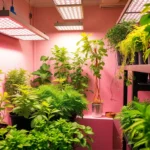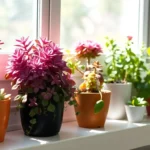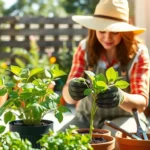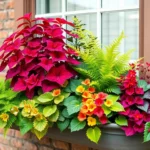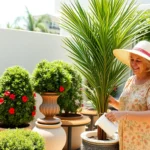Windows aren’t just for letting light in—they’re perfect stages for showcasing nature’s beauty right inside our homes. We’ve discovered that strategic window plant placement transforms ordinary spaces into vibrant living galleries that breathe life into any room.
Whether we’re dealing with sunny south-facing windows or challenging north-facing spots, there’s a plant solution that’ll thrive in every situation. From cascading pothos that create natural curtains to sculptural succulents that add modern flair, window gardening offers endless possibilities for both seasoned plant parents and complete beginners.
The best part? Window plants don’t just look stunning—they actively improve our indoor air quality while creating peaceful green sanctuaries we can enjoy year-round. We’ll show you how to maximize your window real estate with creative arrangements that work beautifully in apartments, houses, and everything in between.
Choose the Right Plants for Your Window Environment
Selecting the perfect plants for your window display requires careful consideration of your exact environment. We’ll guide you through the essential factors that determine which plants will thrive in your window space.
Consider Light Requirements and Window Direction
North facing windows receive the gentlest light throughout the day. We recommend low light plants like pothos, snake plants, and ZZ plants for these spaces. These varieties adapt beautifully to indirect sunlight and won’t develop leaf burn.
East facing windows capture bright morning sun followed by afternoon shade. Spider plants, peace lilies, and Boston ferns flourish in this balanced lighting. Morning sun energizes these plants without overwhelming their delicate foliage.
South facing windows deliver the most intense sunlight during peak hours. Succulents, cacti, and aloe vera plants love this abundant light exposure. These sun loving varieties store water efficiently and handle heat stress exceptionally well.
West facing windows experience hot afternoon sun that can stress many plants. We suggest jade plants, ponytail palms, and rubber trees for these challenging spots. These resilient options withstand temperature fluctuations and intense afternoon rays.
Select Plants Based on Window Size and Space
Small windows work best with compact plants that won’t overwhelm the space. Air plants, small succulents, and mini orchids create stunning displays without blocking natural light. These petite varieties maximize impact while preserving your view.
Medium windows accommodate hanging planters and tiered plant stands effectively. Trailing plants like golden pothos or string of pearls cascade beautifully from window ledges. Multiple plant arrangements create visual depth without crowding the area.
Large windows support dramatic plant collections and floor standing specimens. Fiddle leaf figs, monstera deliciosa, and bird of paradise plants make impressive statements. These substantial plants transform expansive windows into living art installations.
Bay windows offer unique opportunities for wraparound plant displays. Corner plant stands, hanging gardens, and multiple shelf levels maximize this curved space. We recommend mixing plant heights and textures to create ever-changing visual interest.
Factor in Temperature and Humidity Levels
Temperature fluctuations near windows affect plant health significantly throughout seasons. Draft sensitive plants like tropical varieties need protection from cold air leaks. We suggest using weather stripping or relocating delicate plants during extreme weather.
High humidity plants such as ferns and tropical species benefit from grouped arrangements. Clustering plants creates beneficial microclimates that increase local moisture levels. Pebble trays filled with water boost humidity around plant groupings effectively.
Low humidity tolerant varieties like succulents and desert plants adapt to dry indoor air easily. These resilient options maintain their appearance even during winter heating seasons. Snake plants and aloe varieties remain healthy in consistently dry environments.
Seasonal adjustments help plants adapt to changing window conditions throughout the year. Moving plants slightly away from glass during winter prevents cold damage. Summer positioning might require afternoon shade cloth to prevent overheating in intense sunlight.
Create a Stunning Herb Garden Display
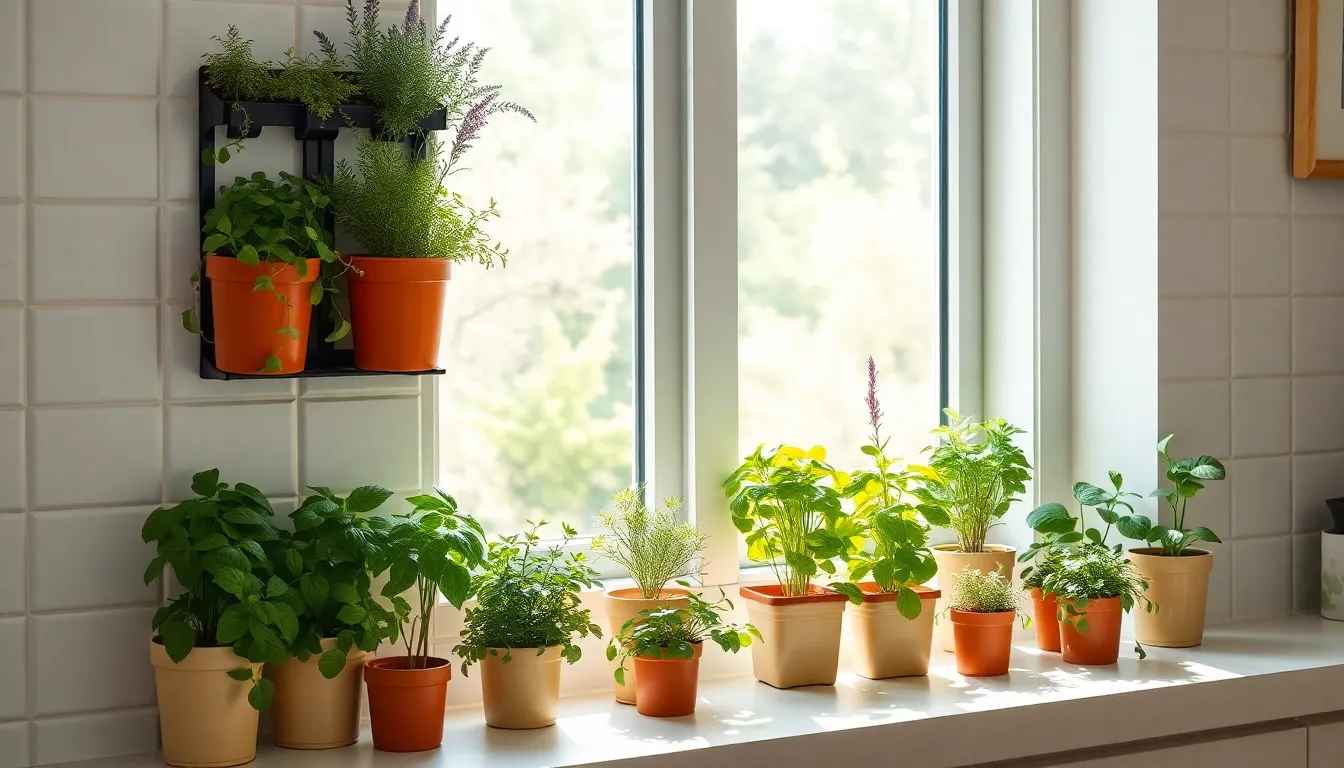
Transforming our window spaces into thriving herb gardens combines beauty with functionality while providing fresh seasonings at our fingertips. Building on our foundation of choosing appropriate plants for different window conditions, herbs offer unique advantages for window gardening success.
Position Culinary Herbs for Easy Access
Placing herbs strategically near cooking areas maximizes their practical value in our daily meal preparation. Kitchen windowsills become prime real estate for frequently used herbs like basil, parsley, and thyme. We’ll find that positioning these culinary favorites within arm’s reach of our stovetop encourages regular harvesting and use.
Selecting the right container sizes prevents common growing mistakes that plague window herb gardens. Small to medium pots work best for most herbs, as oversized containers can lead to waterlogged soil and root problems. We recommend using containers about 6 inches deep for shallow rooted varieties, ensuring we don’t overwhelm delicate herb root systems.
Fast growing herbs like basil thrive when positioned in sunny spots with at least 6 hours of direct sunlight. These sun loving plants reward us with abundant harvests when placed in south or west facing windows. Hardy options like mint prove more forgiving for beginners, adapting well to slightly less optimal lighting conditions.
Design Vertical Herb Arrangements
Maximizing limited window space requires creative vertical answers that showcase multiple herb varieties. Vertical planters with multiple compartments allow us to grow several different herbs in a compact footprint. These arrangements create eye catching displays while efficiently using precious window real estate.
Installing drainage systems prevents the most common cause of herb garden failure in vertical setups. We start by adding gravel to the bottom of each compartment before filling with quality potting soil. This drainage layer protects herb roots from standing water that causes rot and plant death.
Mounting vertical gardens near windows ensures adequate light exposure for healthy herb growth. Wall mounted systems positioned adjacent to bright windows capture sufficient sunlight while keeping herbs accessible for daily harvesting. We can easily reach each compartment for pruning and gathering fresh herbs.
Combine Aromatic and Functional Varieties
Mixing fragrant herbs with culinary varieties creates multisensory window gardens that delight both nose and palate. Aromatic options like lavender and rosemary provide natural air freshening while practical herbs like basil and oregano supply cooking ingredients. This combination approach maximizes the benefits we receive from our window herb displays.
Regular maintenance keeps mixed herb gardens looking attractive and producing abundantly throughout the growing season. Pinching back leggy growth promotes bushier, healthier plants that maintain their decorative appeal. We’ll notice that consistent pruning encourages continuous new growth and prevents herbs from becoming scraggly.
Choosing containers made from breathable materials like terra cotta supports healthy root development across all herb varieties. These natural materials regulate moisture levels automatically, reducing our risk of overwatering different herb types with varying water needs. Cedar and steel containers offer additional durability while maintaining the aesthetic appeal of our window displays.
Design Eye-Catching Succulent Arrangements
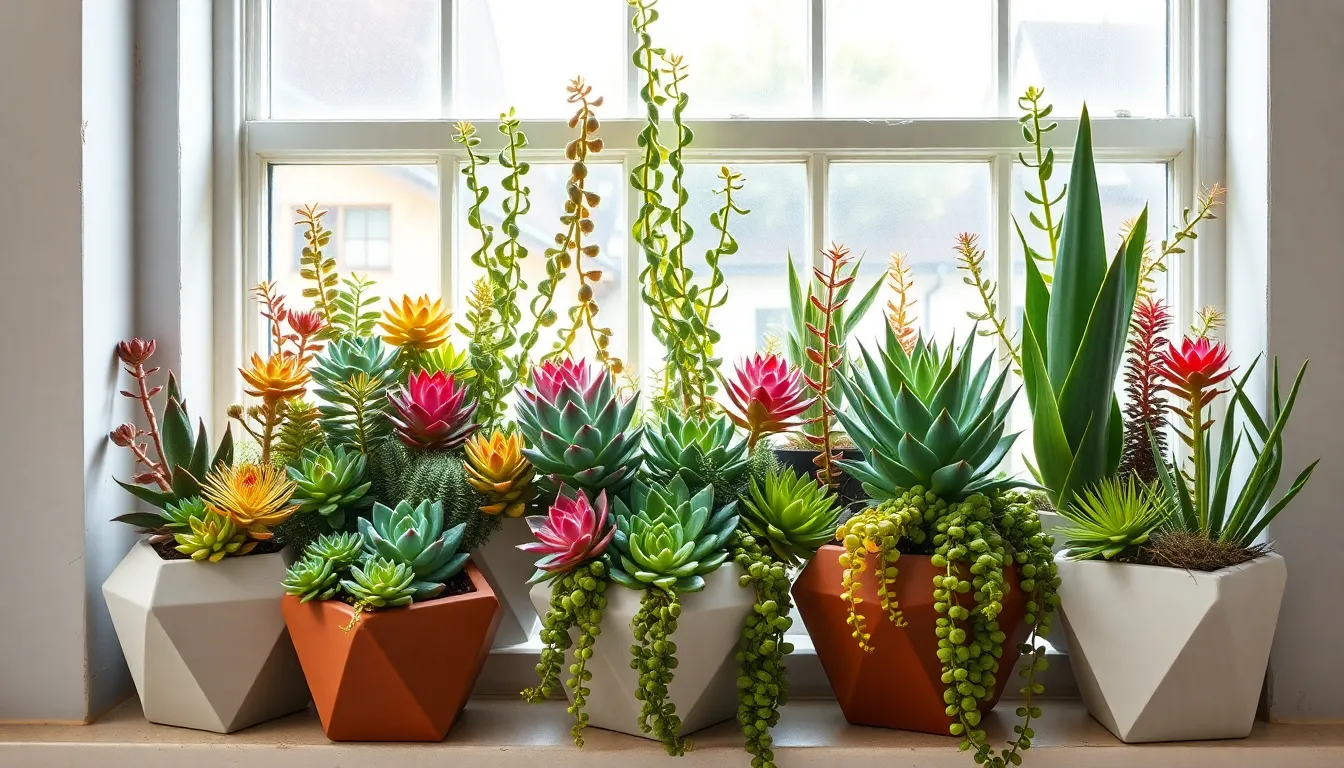
Succulents transform window spaces into stunning focal points with their unique forms and minimal care requirements. We’ll explore how combining different species creates visually striking displays that thrive in bright natural light.
Mix Different Textures and Colors
Combining succulents with varied leaf textures creates rich visual depth in window displays. Smooth rosette forms like echeveria pair beautifully with spiky aloe varieties and fuzzy kalanchoe plants. We recommend grouping different textures in clusters of three or five for maximum impact.
Color variety adds dramatic contrast to succulent arrangements. Deep green jade plants complement silvery blue senecio varieties, while burgundy aeoniums provide bold accent colors. Purple tinted sedum species create striking focal points when positioned near lighter colored varieties.
Seasonal color changes enhance the visual appeal throughout the year. Many succulents develop enhanced pigmentation in bright light, with green varieties showing red or orange edges during peak growing seasons. We’ve found that positioning colorful specimens near window centers maximizes their natural color development.
Use Geometric Planters for Modern Appeal
Geometric planters bring contemporary style to succulent window displays. Hexagonal ceramic pots create structured contrast against organic plant shapes, while cube shaped concrete planters provide stable bases for top heavy varieties. We prefer using materials like metal or glazed ceramic that complement modern interior design.
Grouping geometric containers in symmetrical patterns maximizes visual impact. Three identical triangular planters arranged in a line create clean sight lines, while staggered pyramid shaped pots add dimensional interest. Uniform planter colors help maintain cohesive design aesthetics across multiple containers.
Mixed geometric shapes offer creative flexibility for unique arrangements. Combining rectangular troughs with cylindrical pots creates ever-changing visual tension, while spherical planters soften angular window frame edges. We suggest limiting geometric variety to two or three shapes to maintain sophisticated design balance.
Create Cascading Effects with Trailing Varieties
Trailing succulents add dramatic vertical dimension to window plant displays. String of pearls creates delicate cascading curtains that soften hard window edges, while burro’s tail produces thick rope like trails perfect for high shelf positions. We recommend positioning trailing varieties on upper shelves or hanging planters to maximize their natural draping effect.
Layering trailing plants with upright varieties creates lush multi dimensional displays. Compact echeveria rosettes provide structured bases while string of hearts trails gracefully over pot edges. This combination strategy makes efficient use of vertical space while creating visual depth.
Hanging planters maximize cascading potential in window spaces. Macrame holders suspend trailing varieties at varying heights, creating flowing green curtains that filter natural light beautifully. We’ve found that positioning hanging planters at different levels prevents overcrowding while maintaining dramatic visual impact.
Install Floating Shelves for Multi-Level Gardens
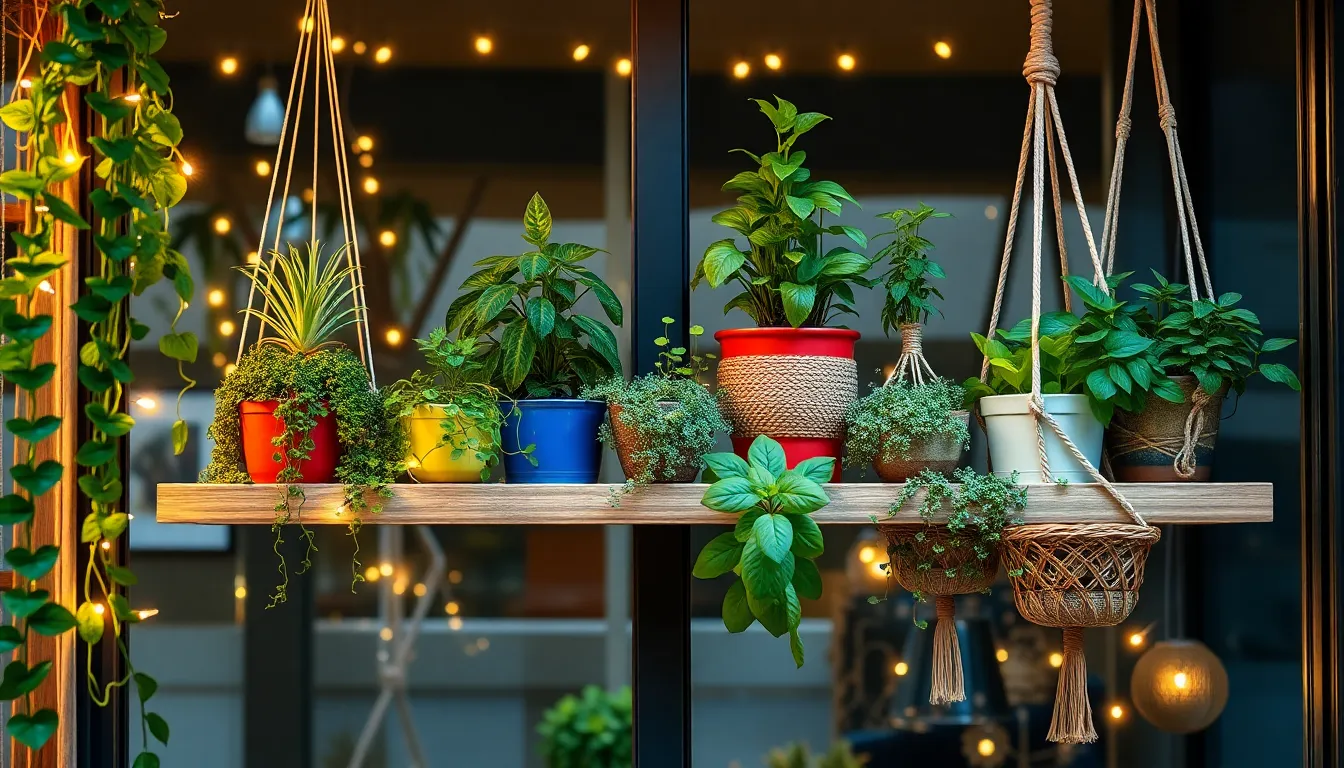
Floating shelves transform ordinary window frames into sophisticated botanical displays that maximize every inch of available space. We’ll show you how to create stunning multi-level gardens that draw the eye upward while ensuring all your plants receive optimal natural light.
Maximize Vertical Window Space
Vertical garden shelves create botanical galleries that make the most of limited window real estate. We recommend installing stacked planters or tiered shelf systems directly on window frames or adjacent walls to establish multiple growing levels without blocking precious sunlight.
These arrangements accommodate an impressive array of plants with different sizes and textures within a compact footprint. Small pots containing herbs like basil and oregano work beautifully on upper shelves, while medium-sized containers holding spider plants or pothos fit perfectly on middle tiers.
Cascading plants like string of hearts or trailing ivy create spectacular green waterfalls when positioned on higher shelves. We’ve found that this vertical approach ensures every plant receives ample natural light while maintaining an organized, gallery-like appearance that transforms windows into living art installations.
Arrange Plants by Height and Growth Patterns
Strategic plant placement based on height and growth habits optimizes both aesthetics and plant health throughout your window display. We position taller specimens or sun-loving plants like rubber trees and fiddle leaf figs closest to the window where they can capture maximum light exposure.
Shorter plants or shade-tolerant varieties such as snake plants and ZZ plants work perfectly in front positions or on lower shelves where they won’t compete for direct sunlight. This layered arrangement creates natural depth and visual interest while ensuring each plant thrives in its ideal lighting conditions.
Growth patterns matter significantly when designing multi-level displays. Upright growers like dracaenas and peace lilies anchor the back rows, while bushy plants like boston ferns fill middle spaces effectively. We always consider mature plant sizes to prevent overcrowding as your window garden establishes itself over time.
Incorporate Decorative Elements and Accessories
Decorative elements elevate functional plant displays into stunning focal points that reflect your personal style. We enhance window gardens with colorful planters, textured ceramic pots, and natural materials like woven baskets that complement both modern and traditional home aesthetics.
Macramé hangers add bohemian charm while suspended at different heights to create ever-changing visual layers. Miniature sculptures, fairy lights, or small decorative stones provide finishing touches that unify the entire arrangement and draw attention to your botanical showcase.
| Decorative Element | Best Use | Visual Impact |
|---|---|---|
| Macramé Hangers | Trailing plants | Creates vertical movement |
| Fairy Lights | Evening ambiance | Adds warm illumination |
| Ceramic Planters | Statement pieces | Provides color coordination |
| Natural Baskets | Casual displays | Brings organic texture |
Color coordination between blooms, foliage, and containers creates cohesive displays that feel intentionally designed rather than randomly assembled. We recommend selecting accessories in complementary colors that enhance your plants’ natural beauty while adding personality to your window space without overwhelming the greenery itself.
Build Custom Window Box Planters
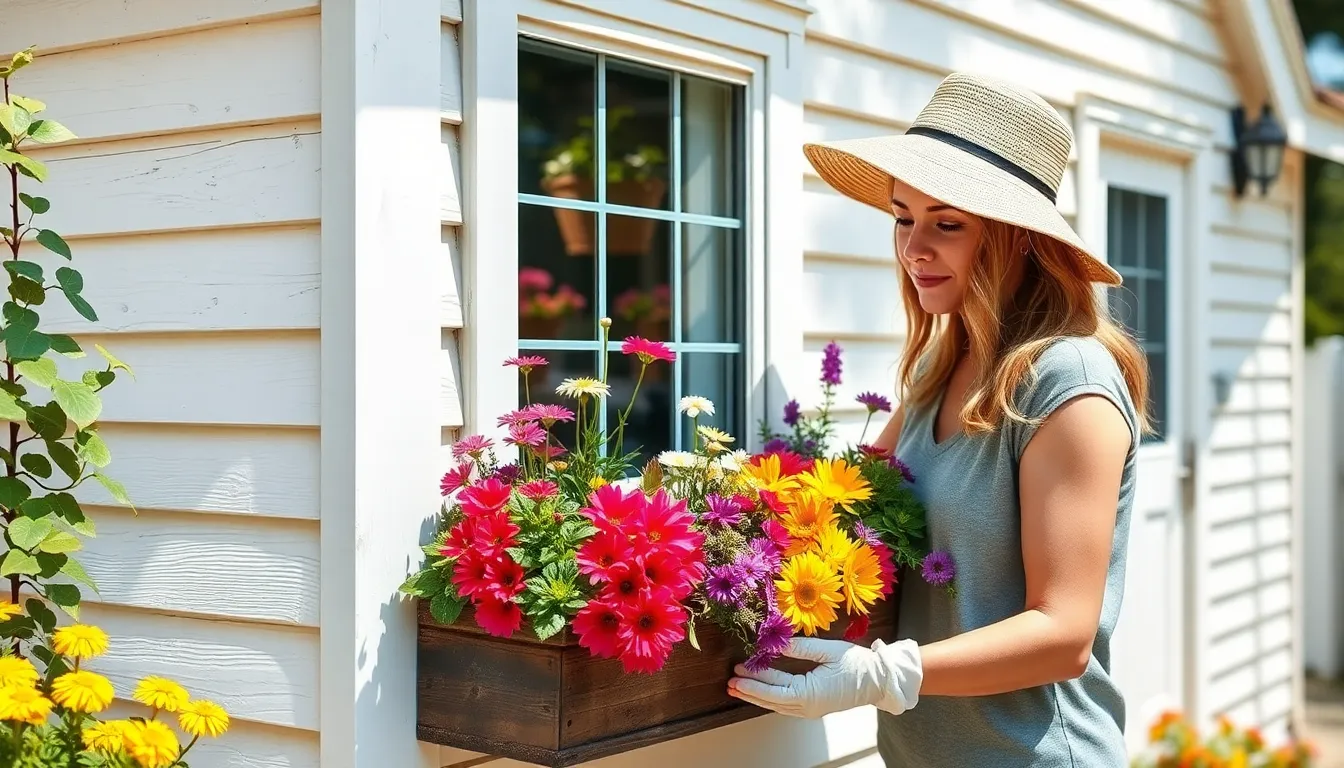
Window box planters transform our exterior spaces with charm and curb appeal while creating opportunities for stunning plant combinations. We can design these custom additions to perfectly complement our home’s architectural style.
Measure and Design for Perfect Fit
Start by measuring your window width to determine the ideal planter length for balanced proportions. We recommend considering both window height and depth when selecting planter dimensions, as standard heights work best for single-story homes while deeper root space accommodates more elaborate plantings on two-story structures.
Design your plant arrangements using the proven “Thriller, Filler, Spiller” method for maximum visual impact. Place a central tall plant as your thriller, surround it with medium-height filler plants, then add trailing spillers along the edges to create beautiful layering and visual interest.
Choose Weather-Resistant Materials
Select materials that withstand outdoor elements year-round for long-lasting beauty. Cellular PVC composite offers exceptional durability, remaining impervious to bugs, rot, and moisture while mimicking natural wood texture that can be painted to match your home.
Cedar provides natural rot resistance with classic appeal, while wrought iron delivers sturdy structural support for heavier plantings. We can enhance longevity by painting or sealing wood and metal planter boxes to maintain their appearance through changing seasons.
Consider using plastic liners inside PVC boxes for easier planting and maintenance, especially when dealing with hard-to-reach windows that make regular care challenging.
Plan for Proper Drainage and Maintenance
Ensure adequate drainage holes in your window boxes to prevent waterlogging and root rot that can destroy entire plantings. Proper drainage systems work alongside liners to simplify cleaning while protecting plant health.
Select plants suited to your window’s exact sun exposure, whether full sun or partial shade, matching your local climate conditions for optimal growth. We recommend regular deadheading of flowers, appropriate watering schedules, and periodic soil nutrient replenishment to maintain vibrant, healthy displays.
Keep maintenance requirements in mind during the planning phase by choosing plant combinations that share similar care needs and seasonal requirements.
Hang Plants at Various Heights for Drama
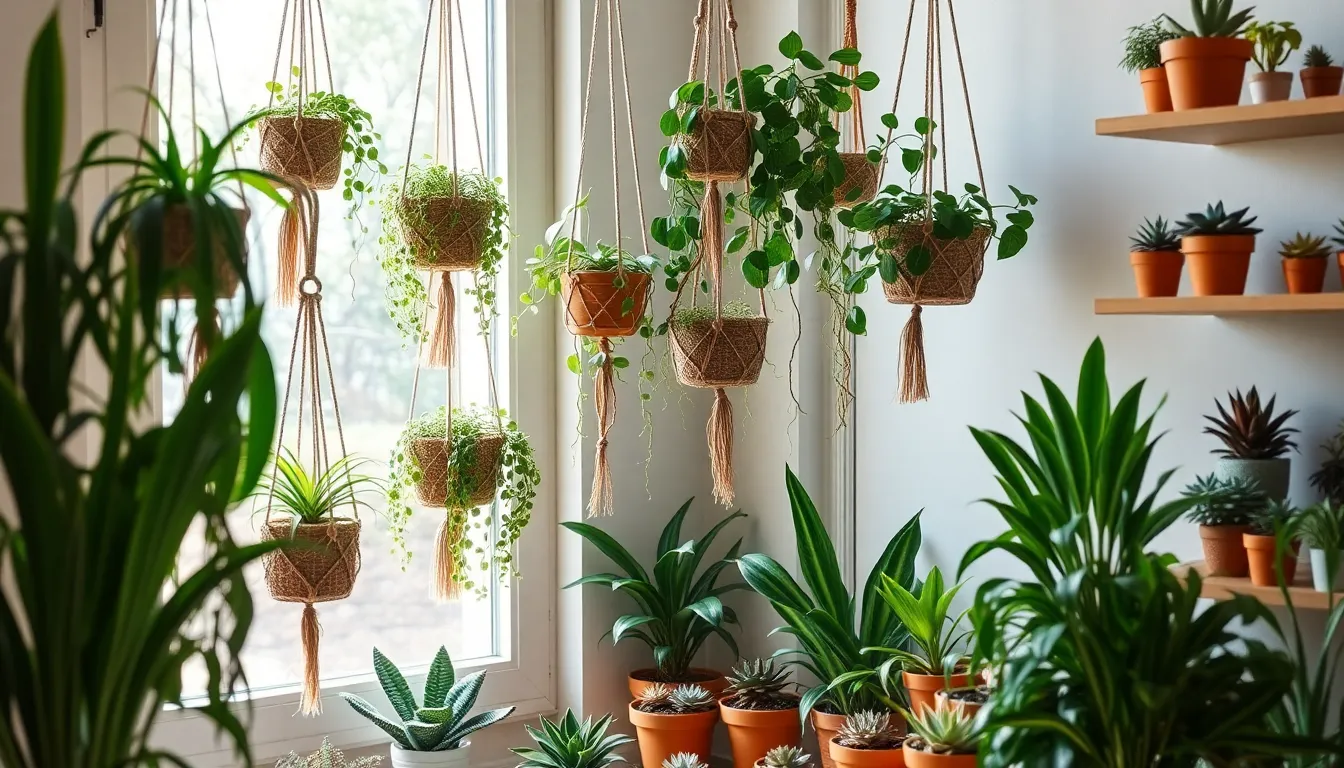
Suspending plants at different elevations transforms your window into a captivating vertical garden that draws the eye upward. This technique creates depth and visual interest while maximizing your growing space in ways traditional shelving simply can’t match.
Use Macrame Hangers for Bohemian Style
Macramé plant hangers bring an artsy, handcrafted element to your window displays that perfectly complements the organic nature of plants. We love how these knotted rope creations add texture and movement to any space while supporting your favorite trailing varieties like pothos or string of hearts.
Choosing different cord colors and knot patterns allows you to customize the bohemian aesthetic to match your home’s style. Natural jute hangers work beautifully in rustic settings, while white cotton macramé creates a clean, modern boho look that won’t compete with your plants’ natural beauty.
The handmade quality of macramé hangers adds authenticity to your window garden display. Installing multiple hangers at varying lengths creates that relaxed, collected-over-time appearance that makes spaces feel lived-in and personal.
Install Ceiling Hooks and Wall Brackets
Ceiling hooks positioned directly above your windows provide the strongest support for heavier hanging planters and baskets. We recommend using heavy-duty hardware rated for at least twice the weight of your planted containers to ensure safety and stability.
Wall brackets mounted beside windows offer flexible positioning options that ceiling hooks can’t provide. These allow you to angle plants toward optimal light while keeping them away from direct glass contact that might cause temperature stress.
Strategic placement of hooks and brackets lets you create that dramatic cascading effect that makes window plants so visually striking. Installing hardware at multiple heights gives you the freedom to rearrange your display as plants grow or seasons change.
Create Layered Displays with Different Plant Types
Combining tall specimen plants with trailing varieties and compact succulents creates the lush, jungle-like atmosphere that makes window gardens so appealing. We suggest positioning your largest plants at floor level, medium-sized varieties on stands or shelves, and trailing species in elevated hangers.
Mixing textures adds visual complexity that keeps viewers engaged with your display. Pair the broad leaves of fiddle leaf figs with the delicate fronds of ferns, then add the geometric forms of succulents for a perfectly balanced composition.
Air plants suspended in glass terrariums bring an ethereal quality to layered window displays. These unique epiphytes require no soil and can be positioned at any height, making them perfect for filling gaps in your vertical arrangement without adding weight to your support system.
Set Up a Mini Greenhouse Effect
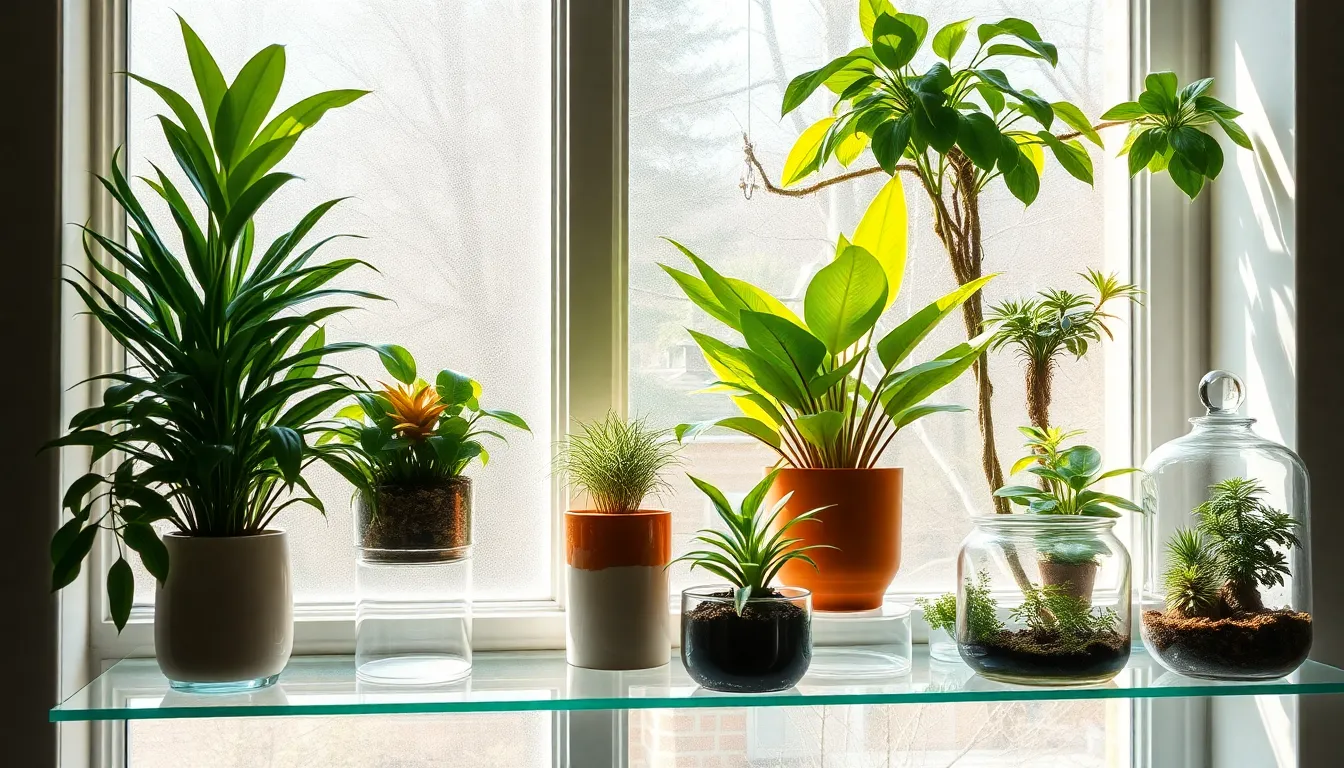
Transform your window space into a thriving microclimate by creating a mini greenhouse that harnesses natural light and warmth for optimal plant growth. Glass shelves positioned inside window frames extend your garden vertically while trapping heat and light to simulate ideal greenhouse conditions.
Position Heat-Loving Plants Strategically
Place heat-loving plants in the warmest, sunniest spots of your window garden where they’ll receive maximum benefit from natural sunlight. East or south-facing windows that capture morning or afternoon sun provide the ideal environment for these temperature-sensitive species. We recommend positioning sun-worshipping plants closer to the glass where sunlight intensity peaks throughout the day.
Strategic arrangement by sunlight requirements optimizes both plant growth and visual display impact. Reserve areas with dappled or indirect light for shade-tolerant varieties while giving prime real estate to those tropical beauties that crave warmth. This thoughtful placement ensures each plant receives its preferred light conditions without compromising the overall aesthetic of your window greenhouse.
Use Glass Containers and Terrariums
Glass containers and terrariums create controlled mini environments that naturally retain humidity and warmth through their transparent walls. These enclosed systems excel at recycling moisture, making them perfect for humidity-loving plants that thrive in consistent atmospheric conditions. Terrariums showcase small ecosystems beautifully while maintaining the precise environment many delicate plants require.
Light penetration from multiple angles improves photosynthesis when plants are housed in clear glass vessels. We find that glass containers not only serve functional purposes but also create stunning focal points that amplify the mini greenhouse effect. Their transparency allows you to observe root development and soil moisture levels while contributing to the overall light-filled atmosphere.
Control Moisture and Air Circulation
Proper moisture and air circulation prevent common problems like mold, mildew, and root rot that can devastate dense window gardens. While glass containers effectively retain moisture, adequate airflow through strategic window openings or proper plant spacing remains essential for plant health. Regular monitoring helps maintain that sweet spot between humidity retention and air movement.
Occasional window opening or small fan usage maintains ideal humidity levels without creating stagnant air pockets. We avoid overwatering, especially in enclosed containers where excess moisture can’t escape naturally. This balanced approach to moisture control ensures your mini greenhouse thrives without the common pitfalls that plague poorly ventilated plant displays.
Incorporate Seasonal Plant Rotations
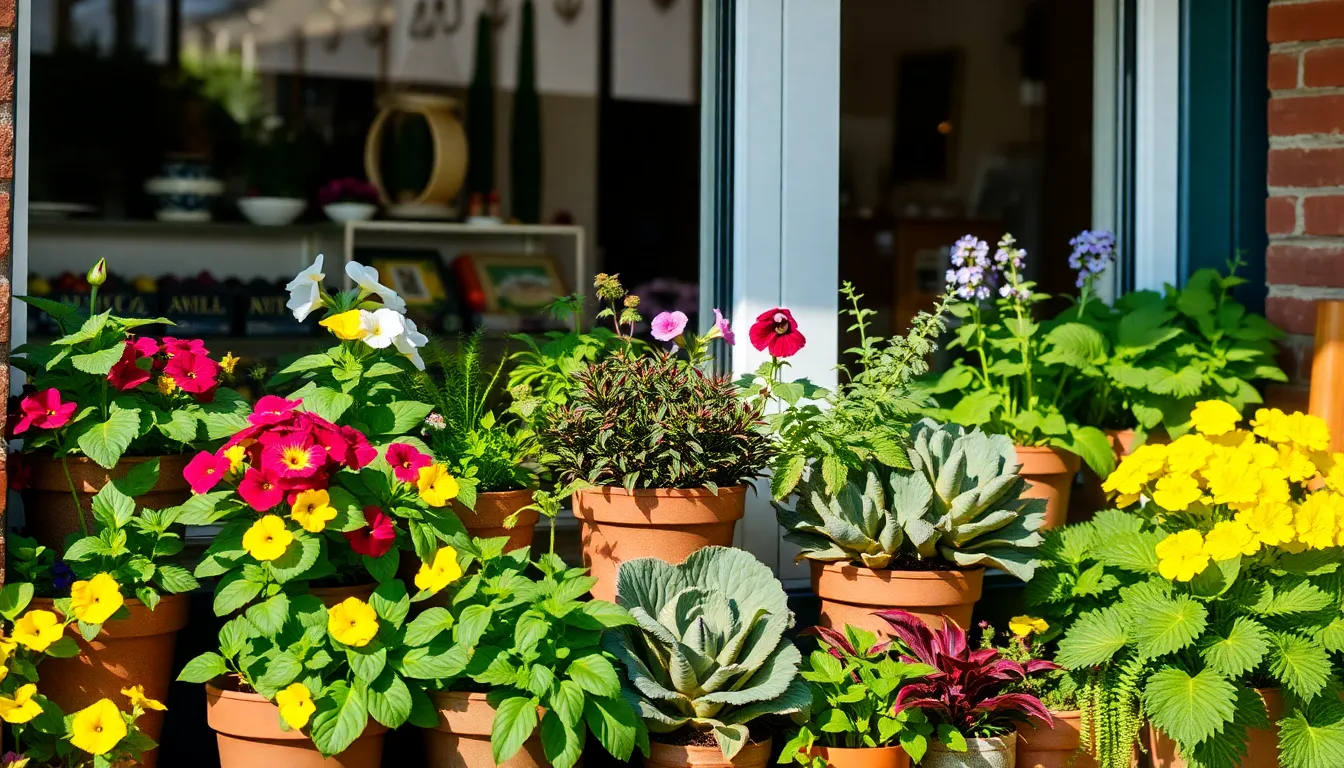
Rotating plants throughout the year keeps our window displays fresh and maintains optimal growing conditions. We can maximize plant health and visual appeal by systematically changing plant varieties based on seasonal requirements.
Plan Spring and Summer Displays
Cool weather champions like pansies and primroses provide early season color in our spring window arrangements. Leafy greens such as lettuce and spinach thrive during cooler months and offer fresh harvests for our kitchen.
Heat loving varieties take center stage as temperatures rise throughout summer months. Herbs like basil and rosemary flourish in warm conditions while providing aromatic benefits for our cooking needs. Tomatoes and peppers add productive elements to sunny window spaces.
Succession planting maintains continuous blooms and harvests by staggering our planting schedules. We plant new seeds every 2-3 weeks to ensure overlapping growth cycles and extended display periods.
Visual layering creates depth through strategic height and color combinations. Tall herbs anchor the back while cascading petunias and marigolds flow over container edges for ever-changing arrangements.
Transition to Fall and Winter Varieties
Autumn hardy selections like chrysanthemums and ornamental kale withstand cooler temperatures while maintaining vibrant colors. These resilient plants bridge the gap between summer heat and winter dormancy periods.
Cold tolerant herbs including sage and thyme continue providing fresh seasonings even as outdoor temperatures drop. We position these varieties in our brightest windows to maximize available light during shorter days.
Indoor evergreen options such as small conifers and hardy houseplants create year round structure in our displays. Cyclamen and poinsettias add seasonal flowering interest without requiring outdoor conditions.
Soil refreshment becomes essential when transitioning between seasons to prevent nutrient depletion. We replace or amend potting mediums before introducing new plant varieties to our containers.
Store Off-Season Plants Properly
Dormancy preparation involves trimming back foliage and roots on perennial plants before storage. We reduce plant size by one third to minimize stress during inactive growing periods.
Storage location requirements include cool temperatures between 35-50°F with indirect light exposure. Basements, garages, or spare rooms often provide ideal conditions for overwintering tender plants.
Watering schedules decrease significantly during storage months to prevent root rot while maintaining slight soil moisture. We check soil weekly and water only when the top inch feels completely dry.
Labeling systems help us track different plant varieties and their exact care requirements during storage. Clear tags with plant names and care notes prevent confusion when spring planting season returns.
Pest monitoring requires monthly inspections to catch problems before they spread to healthy plants. We isolate any affected specimens immediately and treat issues with appropriate organic answers.
Add Decorative Elements to Enhance Your Display
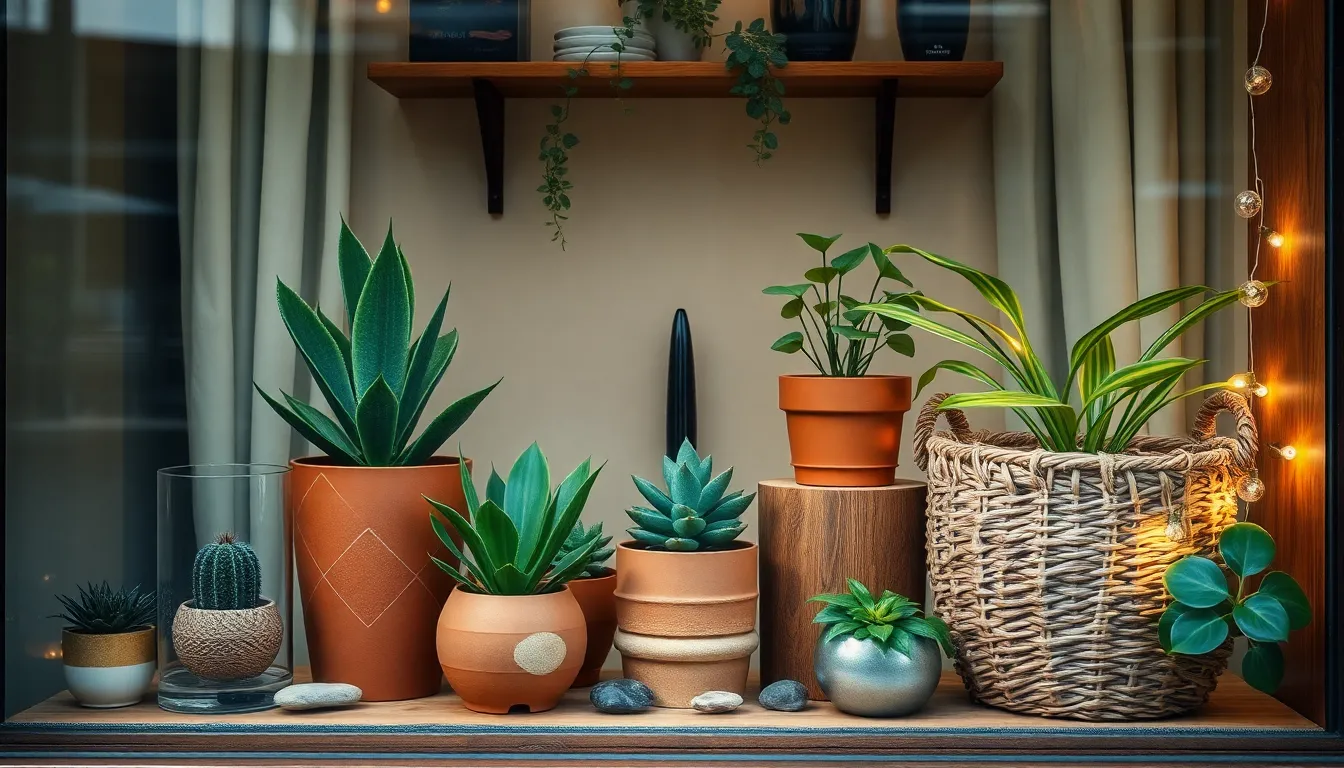
Elevating your window plant display involves more than just selecting the right plants. We can transform our green spaces into stunning focal points by incorporating thoughtful decorative elements that complement our plants while reflecting our personal style.
Choose Complementary Planters and Containers
Selecting planters that harmonize with our home’s aesthetic creates a cohesive and intentional look throughout our window displays. Glass containers work beautifully in modern spaces, offering clean lines that showcase plant roots and soil layers for added visual interest. Ceramic planters provide versatility with their wide range of colors and finishes, allowing us to match existing decor or create striking contrasts.
Woven baskets bring warmth and texture to our arrangements, particularly when we’re aiming for a bohemian or natural aesthetic. We recommend choosing containers in complementary colors rather than identical matches, as this approach creates visual harmony without appearing overly coordinated. Terra cotta pots offer classic appeal and excellent drainage for succulents and herbs, while their earthy tones pair beautifully with greenery.
Different container sizes within the same material family help create ever-changing arrangements that feel intentional rather than random. We suggest grouping planters in odd numbers, as this creates more visually appealing compositions than even numbered arrangements.
Include Natural Materials and Textures
Incorporating organic elements into our window displays creates warmth and connects our indoor gardens to the natural industry outside. Wooden elements like floating shelves or DIY window sill extenders made from reclaimed wood add rustic charm while expanding our planting space significantly. These natural wood accessories complement any plant display while providing functional growing areas.
Stone accents such as river rocks, pebbles, or small decorative stones can serve as both drainage aids and aesthetic elements in our planters. We often place these materials as top dressing to create clean, finished looks while helping retain soil moisture. Driftwood pieces or interesting branches can serve as natural plant supports for climbing varieties or simply as sculptural elements.
Macramé hangers crafted from natural fibers introduce texture and vertical interest to our displays. These hanging answers work particularly well for trailing plants like pothos or string of pearls, creating cascading green waterfalls at our windows. Natural fiber baskets and jute rope elements reinforce the organic theme while providing practical storage for gardening tools or extra supplies.
Balance Plants with Decorative Accessories
Creating harmonious window displays requires balancing our green elements with carefully chosen decorative accessories that enhance rather than overwhelm the space. Small sculptures, ceramic figurines, or nature inspired objects can fill visual gaps between plants while adding personality to our arrangements. We recommend selecting accessories that complement our plants’ scale, avoiding pieces that compete for attention.
Candles placed strategically among our plants create cozy ambiance during evening hours, particularly when we choose natural wax options in neutral containers. Fairy lights woven through larger displays add magical sparkle without detracting from our plants’ natural beauty. These lighting elements become especially important during darker winter months when we want to maintain visual interest.
Decorative stones, crystals, or small mirrors can reflect light and create interesting focal points within our plant groupings. We suggest limiting ourselves to two or three accessory types per display to maintain clean, uncluttered aesthetics. Personal items like small framed photos or meaningful objects help integrate our plant displays into our living spaces, making them feel like natural extensions of our home’s personality rather than separate garden areas.
Maintain Your Window Garden Successfully
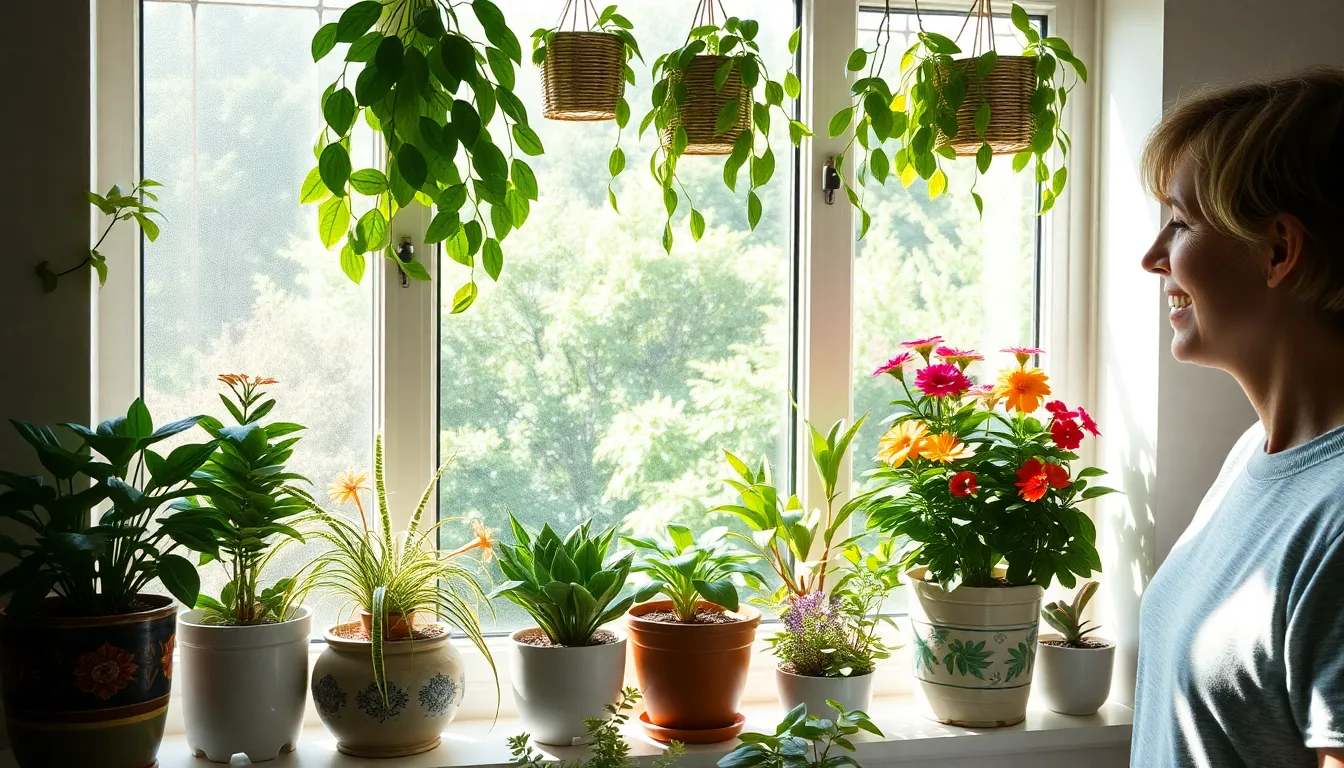
Once you’ve created your beautiful window display, consistent care keeps your plants thriving year-round. We’ve found that successful window gardening depends on three essential maintenance practices.
Establish Watering and Feeding Schedules
Check soil moisture regularly by testing the top 1 to 2 inches of soil before adding water. We recommend allowing this surface layer to dry completely between waterings to prevent root rot in your window plants.
Water from the bottom using saucers filled with water beneath your containers. This technique prevents fungal problems and encourages healthier root development in confined window spaces. Remove excess water after 15 minutes to avoid oversaturation.
Choose containers with drainage holes to prevent “wet feet” conditions that damage plant roots. Well-draining pots are essential for window gardens where air circulation may be limited compared to outdoor growing conditions.
Feed your plants consistently during growing seasons when they’re actively producing new growth. Window plants often need more frequent feeding than outdoor specimens due to limited soil volume in containers.
Monitor for Pests and Disease Issues
Inspect plants weekly for early signs of pest infestations or disease symptoms. We emphasize regular monitoring because confined indoor spaces allow problems to spread quickly between neighboring plants.
Watch for common window garden pests like spider mites, aphids, and fungus gnats that thrive in warm, humid conditions near glass surfaces. Early detection prevents these issues from affecting your entire display.
Ensure proper air circulation around your window plants to reduce fungal problems. Stagnant air combined with moisture creates ideal conditions for plant diseases in enclosed spaces.
Avoid overwatering as excess moisture encourages root rot and attracts pests to your window garden. We’ve observed that most window plant problems stem from watering issues rather than light or temperature concerns.
Prune and Rotate Plants for Optimal Growth
Remove dead or yellowing leaves immediately to encourage new growth and prevent disease spread. Regular pruning keeps your window display looking fresh while redirecting plant energy toward healthy foliage.
Rotate plants every few days so all sides receive even light exposure from your window. This practice promotes balanced, symmetrical growth rather than plants leaning toward the light source.
Harvest herbs frequently to encourage fuller regrowth and better yields from your culinary window plants. We recommend pinching flowers before they develop to maintain leaf production in basil, oregano, and similar herbs.
Trim back overgrown specimens that block light from reaching smaller plants in your window arrangement. Strategic pruning maintains the visual balance of your display while ensuring all plants receive adequate illumination.
Conclusion
Window gardening transforms any living space into a vibrant sanctuary that’s both beautiful and functional. We’ve shown you how proper plant selection lighting consideration and creative arrangements can turn your windows into thriving green displays.
Whether you’re growing fresh herbs for cooking creating stunning succulent arrangements or building custom window boxes there’s a solution for every space and skill level. The key lies in understanding your exact conditions and choosing plants that’ll flourish in your unique environment.
With regular maintenance seasonal rotations and thoughtful decorative touches your window plants will reward you with year-round beauty improved air quality and the satisfaction of successful indoor gardening. Start small experiment with different combinations and watch your confidence grow along with your plants.
Frequently Asked Questions
What are the best plants for north-facing windows?
North-facing windows receive low, indirect light, making them perfect for shade-tolerant plants. Pothos, snake plants, ZZ plants, and peace lilies thrive in these conditions. These plants are also low-maintenance and can handle occasional neglect, making them ideal for beginners or busy homeowners.
How do I choose the right window plants based on window size?
For small windows, choose compact plants like small succulents or herbs. Medium windows work well with cascading varieties like trailing pothos or spider plants. Large windows can accommodate dramatic floor-standing plants like fiddle leaf figs or tall snake plants to create impressive displays.
What plants work best in south-facing windows?
South-facing windows receive the most intense sunlight, making them perfect for sun-loving plants. Succulents, cacti, jade plants, and most herbs thrive in these bright conditions. These plants can handle direct sunlight for several hours without getting scorched or stressed.
How can I create a vertical garden in my window space?
Install floating shelves at different heights to maximize space. Use tiered plant stands, hanging planters, and wall-mounted brackets to create layers. Arrange plants by height with trailing varieties on top shelves and compact plants below. Add macramé hangers for a bohemian touch.
What’s the best way to maintain humidity for window plants?
Group plants together to create natural humidity, use glass containers or terrariums for moisture-sensitive plants, and place water trays near heating vents. Mist plants regularly, but ensure good air circulation to prevent mold and fungal issues in confined window spaces.
How often should I rotate my window plants?
Rotate plants weekly to ensure even light exposure and prevent them from leaning toward the light source. This promotes balanced growth and prevents one side from becoming leggy or weak. Mark your calendar to establish a consistent rotation schedule for best results.
What are the best herbs to grow in window gardens?
Fast-growing herbs like basil, parsley, cilantro, and chives thrive in sunny windows. Mint and oregano are more forgiving of less optimal lighting. Position culinary herbs near your kitchen for easy access while cooking, and use small to medium pots to prevent overcrowding.
How do I prevent root rot in window plants?
Ensure all containers have drainage holes and use well-draining potting mix. Water only when the top inch of soil is dry, and consider bottom watering techniques. Remove excess water from saucers after 30 minutes, and provide adequate air circulation around plants.
When should I change my seasonal plant displays?
Plan seasonal rotations every 3-4 months. Spring brings cool-weather plants like pansies, summer features heat-loving herbs and flowers, autumn showcases hardy varieties, and winter focuses on cold-tolerant plants. Store off-season plants properly and monitor for pests during transitions.
What decorative elements work best with window plant displays?
Choose planters that complement your home’s aesthetic, such as ceramic, glass, or woven baskets. Add natural materials like wood and stone for warmth. Incorporate fairy lights, small candles, or personal decorative items, but limit accessory types to maintain a cohesive, uncluttered appearance.


